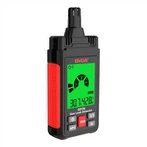Four-in-one gas detector fault detection
The four-in-one gas detector is a single gas or multiple gas detector that can be flexibly configured. It can be equipped with an oxygen sensor, a combustible gas sensor, a toxic gas sensor or any four gas sensors or any single gas. sensor. The four-in-one gas detector has a very clear large LCD screen, backlighting, and audible and visual vibration alarm prompts, ensuring that dangerous gases can be detected in very unfavorable working environments and prompting operators to take precautions in time.
The principle of the detection part of the four-in-one gas detector is that when the measured flammable gas concentration exceeds the limit value, the amplified bridge output voltage and circuit detection set voltage, through the voltage comparator, the square wave generator outputs a set of square wave generators. Wave signal, control sound, light detection circuit, the buzzer produces continuous sound, the light-emitting diode flashes, and sends out a detection signal. From the principle of the four-in-one gas detector, it can be seen that if electromagnetic interference occurs, it will affect the detection signal and cause data deviation; if there is a collision or vibration that causes the equipment to be disconnected, detection failure may occur; if the environment is too humid or the equipment has water ingress, it may also occur. It will cause a short circuit in the four-in-one gas detector, or the circuit resistance value will change, causing detection failure.
Formaldehyde is a colorless, soluble, irritating gas. Man-made panels such as particleboard, density board, and plywood, adhesives and wallpaper are the main sources of formaldehyde in the air, with a release period of 3 to 15 years. It can be absorbed through the respiratory tract. The harm of formaldehyde to the human body is characterized by long-term, latent and hidden effects. Long-term inhalation of formaldehyde can cause serious safety problems such as nasopharyngeal cancer and laryngeal cancer.
For example: after formaldehyde is connected to paper, the reagent contained in the paper will react with formaldehyde to form a compound, and the color will change from white to yellow. The degree of discoloration reflects the amount of reflected light received. The intensity change rate of the reflected light amount can be used as a response to the gas concentration. By setting the calibration curve in advance, the concentration of the gas can be determined based on the response value of the gas to be detected.
The four-in-one gas detector consists of two parts: detection and detection, and has detection and detection functions. The principle of the detection part of the four-in-one gas detector is that the sensor of the instrument uses a detection element, a fixed resistor and a zero-adjusting potentiometer to form a detection bridge. The bridge uses platinum wire as a carrier to catalyze the element. After power is applied, the temperature of the platinum wire rises to the operating temperature, and the air reaches the surface of the element through natural diffusion or other methods. When there is no flammable gas in the air, the output of the bridge is zero. When the air contains flammable gas and diffuses to the detection element, flameless combustion occurs due to catalysis, which increases the temperature of the detection element and increases the resistance of the platinum wire. , causing the bridge circuit to lose balance, thereby outputting a voltage signal. The magnitude of this voltage is proportional to the concentration of flammable gas. The signal is amplified, analog-to-digital converted, and the concentration of flammable gas is displayed on the liquid display.






